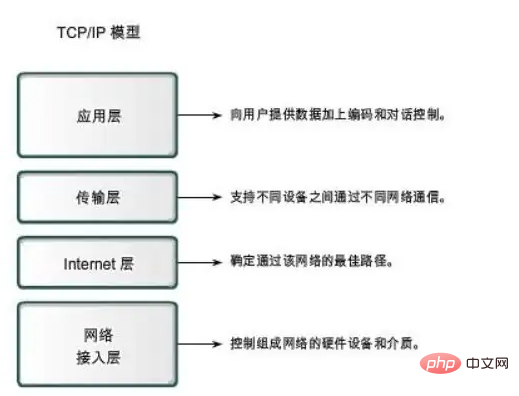Which network protocol does the Internet use?
The network protocol used by the Internet is "TCP/IP protocol". TCP/IP refers to Transmission Control Protocol/Internet Protocol, also known as network communication protocol. It is a protocol suite that can realize information transmission between multiple different networks. The TCP/IP transmission protocol stipulates the standards and methods for communication between various parts of the Internet; and, the TCP/IP transmission protocol is two important protocols that ensure the timely and complete transmission of network data information.

The operating environment of this tutorial: Windows 7 system, Dell G3 computer.
The network protocol used by the Internet is "TCP/IP protocol".
TCP/IP (Transmission Control Protocol/Internet Protocol), also known as network communication protocol, refers to a protocol suite that can realize information transmission between multiple different networks . The TCP/IP protocol not only refers to the two protocols TCP and IP, but also refers to a protocol cluster composed of FTP, SMTP, TCP, UDP, IP and other protocols. Just because in the TCP/IP protocol, the TCP protocol and the IP protocol The most representative, so it is called TCP/IP protocol.
TCP/IP transmission protocol is the most basic communication protocol used in the network. The TCP/IP transport protocol stipulates the standards and methods for communication between various parts of the Internet. Moreover, TCP/IP transmission protocols are two important protocols that ensure timely and complete transmission of network data information. The TCP/IP transmission protocol is strictly a four-layer architecture, including the application layer, transport layer, network layer and data link layer.

TCP/IP protocol is the most basic protocol of the Internet. The main protocols of the application layer include Telnet, FTP, SMTP, etc., which are used to receive data from the transport layer or Transmit data to the transport layer according to different application requirements and methods; the main protocols of the transport layer are UDP and TCP, which are channels for users to use the platform and the internal data of the computer information network to achieve data transmission and data sharing; the main protocols of the network layer The protocols include ICMP, IP, and IGMP, which are mainly responsible for the transmission of data packets in the network; the network access layer, also called the network interface layer or data link layer, has the main protocols ARP and RARP, and its main function is to provide link management error detection. , effectively handle information details related to different communication media, etc.
Features
The TCP/IP protocol can develop rapidly and become a de facto standard because it just meets the needs of data communication around the world. It has the following characteristics:
(1) The protocol standard is completely open, can be used by users for free, and is independent of specific computer hardware and operating systems.
(2) It is independent of the network hardware system, can run on the wide area network, and is more suitable for the Internet.
(3) Network addresses are uniformly allocated, and each device and terminal in the network has a unique address.
(4) High-level protocol standardization can provide a variety of reliable network services.
For more related knowledge, please visit the FAQ column!
The above is the detailed content of Which network protocol does the Internet use?. For more information, please follow other related articles on the PHP Chinese website!

Hot AI Tools

Undresser.AI Undress
AI-powered app for creating realistic nude photos

AI Clothes Remover
Online AI tool for removing clothes from photos.

Undress AI Tool
Undress images for free

Clothoff.io
AI clothes remover

Video Face Swap
Swap faces in any video effortlessly with our completely free AI face swap tool!

Hot Article

Hot Tools

Notepad++7.3.1
Easy-to-use and free code editor

SublimeText3 Chinese version
Chinese version, very easy to use

Zend Studio 13.0.1
Powerful PHP integrated development environment

Dreamweaver CS6
Visual web development tools

SublimeText3 Mac version
God-level code editing software (SublimeText3)

Hot Topics
 1386
1386
 52
52
 What is public IP
Sep 27, 2021 am 10:30 AM
What is public IP
Sep 27, 2021 am 10:30 AM
Public IP refers to a non-reserved address connected to the Internet using the public network, and can be freely accessed by other computers on the Internet. Each computer on the Internet has an independent IP address. This IP address uniquely identifies a computer on the Internet. This IP address refers to the public IP address.
 How to solve the problem of unable to access the Internet in win11? Guide to solving the problem of Win11 computer being unable to connect to the internet
Jan 29, 2024 pm 08:57 PM
How to solve the problem of unable to access the Internet in win11? Guide to solving the problem of Win11 computer being unable to connect to the internet
Jan 29, 2024 pm 08:57 PM
When we use computers, we are all connected to the Internet. Only with the Internet can we surf the Internet. Recently, many users have asked me how to solve the problem of Win11 unable to connect to the Internet? Users can directly open the best matching service application provided by the system to set it up. Let this site carefully introduce to users the solution to the problem that Win11 computers cannot access the Internet. Solution 1 for Win11 computers unable to access the internet: You can press the Win+S key combination, or click the search icon next to the bottom taskbar to open the Windows search window. Enter "service" in the search box, and then click to open the best matching service application given by the system. Method Two
 What is the communication protocol of the internet?
Dec 24, 2020 pm 02:53 PM
What is the communication protocol of the internet?
Dec 24, 2020 pm 02:53 PM
The main communication protocol used by the Internet is "TCP/IP protocol", TCP/IP transmission protocol, namely transmission control/network protocol, also called network communication protocol; it is the most basic communication protocol in the use of the network, TCP/IP The IP transport protocol stipulates the standards and methods for communication between various parts of the Internet.
 What are the network protocols in Go language?
Jun 10, 2023 pm 02:06 PM
What are the network protocols in Go language?
Jun 10, 2023 pm 02:06 PM
In recent years, Go language, as an efficient, lightweight, and excellent concurrency programming language, has attracted more and more people's attention and love. In terms of network programming, the Go language has rich network protocol support and can help developers build network applications quickly and conveniently. Let's take a look at the network protocols in Go language. 1.TCPTCP (TransmissionControlProtocol, Transmission Control Protocol) is a transmission protocol commonly used in computer networks.
 How to set up Windows 11 without an Internet connection
Apr 15, 2023 am 10:46 AM
How to set up Windows 11 without an Internet connection
Apr 15, 2023 am 10:46 AM
Starting with build 22557 and later, Windows 11 requires an Internet connection to complete first-time setup, also known as the Out-of-Box Experience (OOBE) for Home and Pro editions, although there is a way to bypass this requirement entirely. Since Microsoft wants users to connect their computers to their Microsoft accounts, the company is making changes to the initial Windows 11 setup that will make it nearly impossible to proceed with a clean installation without an Internet connection. Alternatively, if Settings detects that the device has no network connection, you will be sent to the Oops, you lost your Internet connection screen. If you click on the retry option you will see Connect to the Internet again
 What are the common protocols for Java network programming?
Apr 15, 2024 am 11:33 AM
What are the common protocols for Java network programming?
Apr 15, 2024 am 11:33 AM
Commonly used protocols in Java network programming include: TCP/IP: used for reliable data transmission and connection management. HTTP: used for web data transmission. HTTPS: A secure version of HTTP that uses encryption to transmit data. UDP: For fast but unstable data transfer. JDBC: used to interact with relational databases.
 How to delete temporary Internet files
Dec 06, 2023 am 10:56 AM
How to delete temporary Internet files
Dec 06, 2023 am 10:56 AM
Steps to delete temporary Internet files: 1. Press win+r to open "Run", enter: %temp% command in the run dialog box, click OK or press Enter to open the user account temporary folder; 2. After opening the Temp folder Press the Ctrl+A keys, select all temporary files, right-click, and click "Delete" in the right-click menu; 3. If there are individual temporary files that cannot be deleted, restart the computer to delete them.
 What are the three elements of network protocols?
Dec 09, 2020 am 10:23 AM
What are the three elements of network protocols?
Dec 09, 2020 am 10:23 AM
The three elements of the network protocol: 1. Semantics, which explains the meaning of each part of the control information; it stipulates what kind of control information needs to be sent, as well as the completed actions and what kind of responses should be made. 2. Grammar, that is, the structure and format of user data and control information, and the order in which data appears. 3. Timing, that is, a detailed description of the sequence of events.



